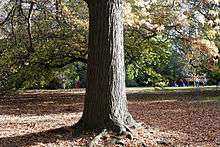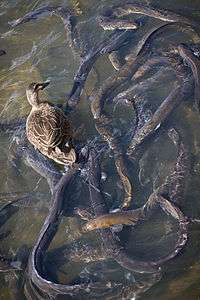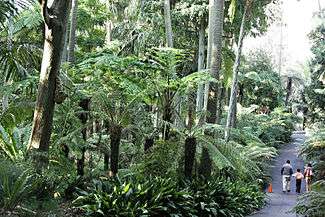Royal Botanic Gardens, Melbourne
| Royal Botanic Gardens Melbourne | |
|---|---|
|
A section of the Fern Gully in the Royal Botanic Gardens | |
| Type | Public Park |
| Location | Melbourne, Australia |
| Area | 38 hectares |
| Opened | 1846 |
| Operated by | Board of the Royal Botanic Gardens |
| Visitors | 1 million (approx. per year) |
| Status | Open (7:30–9 am to sunset) |
| Paths | Sealed |
| Terrain | Low undulating hills |
| Water | Yarra River, Ornamental Lake, Nymphaea Lake |
| Vegetation | Australian Native, Lawns, Non-native traditional gardens |
| Connecting transport | Train, Tram, Bus, Car |
| Landmarks | Yarra River, Ornamental Lake, National Herbarium |
| Facilities | Information centre, Gift shop, Toilets, Barbecues, Shelter, Cafe and Tea rooms |
| Website | rbg.vic.gov.au |
The Royal Botanic Gardens Melbourne are internationally renowned botanical gardens located near the centre of Melbourne, Victoria, Australia, on the south bank of the Yarra River. They are 38 hectares (94 acres) of landscaped gardens consisting of a mix of native and exotic vegetation including over 10,000 individual species.
The Royal Botanic Gardens have a second division in the outer Melbourne suburb of Cranbourne, some 45 km south-east of the city. The 363 hectare (897 acres) Royal Botanic Gardens, Cranbourne have a focus solely on Australian native plants, and feature an award-winning special section called the Australian Garden, which was opened in May 2006.
The Royal Botanic Gardens Melbourne are adjacent to a larger group of parklands directly south-east of the city, between St. Kilda Road and the Yarra River known as the Domain Parklands, which includes;
Governance and history
The gardens are governed under the Royal Botanic Gardens Act 1991 by the Royal Botanic Gardens Board, who are responsible to the Minister for Environment.
In 1846 Charles La Trobe selected the site for the Royal Botanic Gardens from marshland and swamp.
In 1857 the first director was Ferdinand von Mueller, who created the National Herbarium of Victoria and brought in many plants.
In 1873 William Guilfoyle became Director and changed the style of the Gardens to something more like the picturesque gardens that were around at that time. He added tropical and temperate plants.
In 1877 Sir Edmund Barton, Australia's first Prime Minister and Jane Ross were married at the Royal Botanic Gardens.
In 1924 a shooting massacre occurred at the Gardens resulting in the death of four people.[1][2]
Horticulture

Living collections at the Botanic Gardens include Australian Forest Walk, California Garden, Cacti and Succulents, Camellia Collection, Cycad Collection, Eucalypts, Fern Gully, Grey Garden, Herb Garden, Long Island, New Caledonia Collection, New Zealand Collection, Oak Lawn, Perennial Border, Roses, Southern China Collection, Tropical Display-Glasshouse, Viburnum Collection and Water Conservation Garden.
These plant groups have been chosen for their value, rarity, diversity and interest.
Ecology
The gardens include a mixture of native and non-native vegetation which invariably hosts a diverse range of both native and non-native fauna. The gardens host over 10,000 floral species, the majority being non-native species. The gardens were the origin from which many introduced species spread throughout south-eastern Australia as seeds were traded between early European botanists in the mid-19th century, studying the Australian flora.
Native vegetation
From the gardens establishment in 1846, much of the native vegetation was removed as botanists such as Baron Von Mueller planted a range of species from around the world. While initially much of the native wetlands and swamplands in the gardens were left, around the turn of the 20th century these were re-landscaped to create the Ornamental Lake. Despite this however, there are some large eucalypts remaining including the prominent Separation Tree, a 300-year-old River Red Gum, under which Victoria was declared a separate colony. In August 2010 the Separation Tree was attacked by vandals and it is not clear if it will survive.[3] The Royal Botanic Gardens, Cranbourne focus solely on Australian native plants.
Non-native traditional gardens
The Royal Botanic Gardens Melbourne were initially intended to be a horticultural exhibition for the public to enjoy, many seeds were traded between early European botanists such as Arthur and Von Mueller, who planted non-native species. The Queen and her grandfather, Dame Nellie Melba and Paderewski contributed plantings on occasions throughout the gardens history. Much of the gardens have been separated into themed sections such as:
- Herb Garden
- Arid Garden
- Fern Gully
- Bulbs
- Rose Garden
Lawns
The gardens host areas of non-native tough-wearing lawns of various sizes that are carefully maintained;
- Huntingford Lawn
- Hopetoun Lawn
- Northern Lawn
- Tennyson Lawn
- Princes Lawn
- Central Lawn
- Western Lawn
- Eastern Lawn
- Oak Lawn
- Southern Lawn
- Australian Lawn
Plant science
Since its earliest days, the Royal Botanic Gardens is involved in plant research and identification. This is done primarily through the National Herbarium of Victoria, which is based at the Gardens. The Herbarium is also home to the State Botanical Collection, which includes over 1.2 million dried plant specimens, and an extensive collection of books, journals and artworks. Research findings are published in the journal Mulleria, which is a scientific representation of the work done in the Gardens in any one year. More recently, the Australian Research Centre for Urban Ecology has been established to look at plants which grow in urban environments specifically.
Education and visitor information
Opening hours
The Gardens are open every day of the year at 7.30am and close at dusk.
The Gardens Visitor Centre is open seven days a week:
- Weekdays 9.00am – 5.00pm
- Weekends 9.30am – 5.00pm
Transport The Gardens are a 15-minute walk or 5-minute tram ride from Flinders Street Station to the Domain Road Interchange on tram routes 3, 5, 8, 16, 64, 67. Street parking is available for 2- to 4-hour periods.
The Ian Potter Foundation Children's Garden
The 5,000 square metre Ian Potter Foundation Children's Garden is designed as a discovery area for children of all ages and abilities. The Ian Potter Children's Garden is based in South Yarra, off the main site. This area is closed for two months of the year from the end of the Victorian July school holidays for rest and maintenance.[4]
The Tan
.jpg)
The Tan Track, more usually called The Tan, is a track parallel to the perimeter fence of the Botanic Gardens. Originally a tanbark horse riding track for Melbourne's well-heeled, The Tan has been extended to form a 3.84-km running circuit with a surface of tan-coloured stone aggregate.
The Tan is now one of Melbourne's most frequented locations for joggers. Locals, visitors and famous alike now share the space as its international reputation has grown. The Tan is often used in training by professional athletes, such as AFL footballers, particularly during pre-season time-trials. Running greats such as Hicham El Guerrouj, Steve Ovett, Cathy Freeman, and Sonia O'Sullivan have all rubbed shoulders with the general public on The Tan.
The quickest lap of the Tan has been held by such notable Australian runners as Robert de Castella and Steve Moneghetti (10:41, 2003). The current record is 10 minutes and 12 seconds, run by Craig Mottram in 2004. On 21 December 2006, Craig Mottram unofficially broke his personal best time around the tan, running a scorching 10 minutes and 8 seconds while running with the Richmond Football Club during their pre-season training. He gave the footballers a two-and-a-half minute head start and still managed to beat them comprehensively.[5]
The inaugural Go the Tan run was held in early February 2006, and provides the opportunity for participants to run, jog or walk around The Tan and receive an official time.[6]
The Corporate Cup, a team based lunchtime running program has been held at the Tan Track for over thirty years. The Corporate Cup provides team and individual statistical analysis of running times over an 8-week program.[7]
Challenges for the Botanic Gardens

Ongoing issues for the Botanic Gardens have included unwanted plants and challenging animal life.
Beginning in 2001, the Royal Botanic Gardens had a significant challenge managing a colony of endangered indigenous grey-headed flying foxes. Like all flying fox colonies it was noisy and occasionally emitted a musty odour that was thought to detract from the garden's amenity.
Eventually the colony was relocated to bushland at Yarra Bend Park in Kew. The bats are important pollinators and seed dispersers of 100 species of native trees and plants including endangered rainforest and palm species. Through its Australian Research Centre for Urban Ecology unit (ARCUE) the RBG continues to take a keen interest in the welfare of the colony.
In regard to weeds (always a problem with a botanic gardens of this size) the Botanic Gardens developed a strategic plan in 2004 to minimise weed infestations by educating the public and management, and to help conserve the indigenous and other species.
See also
- Kirsten Parris, urban ecologist
Gallery
 Map of gardens
Map of gardens- Ornamental Lake
 A section of the gardens in winter
A section of the gardens in winter Nympheas Lake
Nympheas Lake The Herb Garden
The Herb Garden.jpg) The main entrance gate
The main entrance gate
References
- ↑ Massacre at the Botanical Gardens Accessed 24 September 2007
- ↑ "The Botanic Garden's Mass Murderer". Odd Australian History of the Berwick/Pakenham region. Retrieved 19 November 2012.
- ↑ Police probe 'sickening' attack on historic tree - ABC News, accessed 2 September 2010
- ↑ "The Ian Potter Foundation Children's Garden". Royal Botanic Gardens Official Website. Royal Botanic Gardens, Melbourne. n.d. Retrieved 2008-07-30.
- ↑ Stevens, Michael (2006-12-22). "Mottram gives Tigers a tanning". Herald Sun. Herald and Weekly Times. Retrieved 2008-07-30.
- ↑ "2013 Go The Tan, 15-16 February". Start to Finish Event Management. Retrieved 17 November 2012.
- ↑ "Weightman Announced as Corporate Cup Ambassador". Lisa Weightman. 17 August 2012. Retrieved 19 November 2012.
External links
| Wikimedia Commons has media related to Royal Botanic Gardens, Melbourne. |
Coordinates: 37°50′00″S 144°58′49″E / 37.83340°S 144.98033°E
